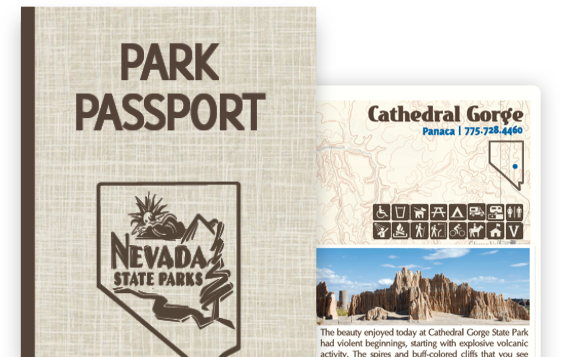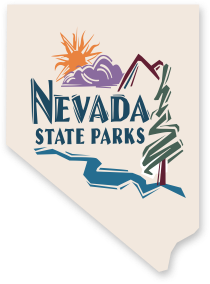Ice Age Fossils
State Park

About Ice Age Fossils
Officially announced in January of 2017 as part of Governor Brian Sandoval’s “Explore Your Nevada Initiative”, this 315 acre park features a portion of the upper Las Vegas wash that is rich in both paleontological and historical resources. During the Pleistocene, also known as the Ice Age, the wash provided verdant habitat for several species of now extinct mammals, including Columbian mammoths, American lions, camels, dire wolves, and ground sloths. The discovery of abundant fossils onsite triggered a long history of scientific research, which includes the famous “Big Dig” of 1962-3, the largest inter-disciplinary scientific expedition of its kind up to that point.
FACILITIES & AMENITIES
Group Area: A large shade structure with picnic tables is located near the visitor center.
Picnicking: The large shade structure near the visitor center offers seating and tables for picnicking.
Visitor Center: The Visitor Center offers natural history exhibits, restrooms, drinking water, covered outdoor seating, and a gift shop.
Programs: Information about program schedules may be obtained from park staff. Group tours or programs may be available upon request.
Megafauna Trail: This 0.3-mile trail has life-sized sculptures that reveal the lives and behaviors of the massive animals that once roamed Tule Springs. The trail begins near the back patio of the visitor center and ends between the visitor center and restroom building.
Las Vegas Wash Trail: This 1.5-mile trail begins and ends at the Monumental Mammoth. Hikers will experience the natural forces that created and reshaped this landscape over the course of millennia as they hike through the Upper Las Vegas Wash. The park is dry most of the year but always check with park staff for current wash conditions.
Big Dig Trail: This 1.2-mile trail begins and ends at the Trench K Trailhead. This trailhead is accessible by a 0.5-mile connector trail from the Megafauna Trail. Relive the discoveries of past scientists while hiking through trenches bulldozed by the Tule Springs Expedition. The park is dry most of the year but always check with park staff for current conditions in the wash and the trenches.
Park Hours: Wednesday - Sunday 8:00am - 4:30pm
FIELD NOTES
- Removing, disturbing or damaging any historic structure, artifact, rock, plant life, fossil or other feature is prohibited. State and federal laws protect this area and its resources.
- The flying of drones or other unmanned aircraft in the park is prohibited.
- Operating an OHV, UTV, or any other type of motorized vehicle is prohibited.
- Camping and campfires are prohibited within the park boundaries.
- Pets are welcome, but they must be kept on a leash of not more than six feet in length.
- Visitors are responsible for knowing all park rules and regulations in effect. Detailed rules and regulations are posted at the park or may be viewed on the Park Rules page.
- Those with developmental and/or physical limitations are invited to enjoy all of the recreational activities of Nevada State Parks. If you would like to request additional support or accommodations, please call the Nevada State Parks division office. We continually seek ways to provide recreational opportunities for people of all abilities and welcome any suggestions you may have.
- View a list of frequently asked questions.
History of Ice Age Fossils State Park
At the peak of the last Ice Age, roughly 25,000 years ago, the Las Vegas area was wet and green. Marshlands extended across the valley floor. Looking out over the vegetated landscape, herds of Megafauna, like ancient bison, camels, and Columbian mammoths, would have been a common sight.
Over time, the land began to change. The wetlands were drying up, leaving behind spring-fed streams as the area transitioned to today’s arid landscape. By the end of the last Ice Age, the large animals that once called this place home were disappearing. It was around this time, roughly 12,000 years ago, that humans began leaving their mark in the valley. The earliest known human inhabitants of the valley would have walked alongside the remaining megafauna. Read More
get outdoors
Find a Park Event

Coffee Talk
Read More

Fossil Feature
Read More

First Birthday Fun, Games, & Crafts
Read More
push your boundaries
Explore More Nevada State Parks

Old Las Vegas Mormon Fort
More than 150 years ago, a spring-fed creek flowed through the Las Vegas Valley, creating an oasis in the desert where Mormon missionaries built an adobe fort. Today the park includes a remnant of the original fort that is used to display historic artifacts.
- Quick Look
- Full Park Detail

Old Las Vegas Mormon Fort
Las Vegas, Nevada- Amenities
- View Description
- Full Park Detail

Spring Mountain Ranch
The first working ranch in the Las Vegas Valley, and once a luxurious retreat for millionaire Howard Hughes, Spring Mountain Ranch attracts visitors who enjoy exploring historic buildings, hiking and large, lush lawns on which to picnic and play.
- Quick Look
- Full Park Detail

Spring Mountain Ranch
Blue Diamond, Nevada- Amenities
- View Description
- Full Park Detail

Valley of Fire
A geologic wonderland, world-renowned Valley of Fire has 2,000 year old petroglyphs carved into massive red sandstone formations in the Mohave Desert. These stunning and unique sandstone formations were formed from shifting sand dunes 150 million years ago.
- Quick Look
- Full Park Detail

Valley of Fire
Overton, Nevada- Amenities
- View Description
- Full Park Detail


